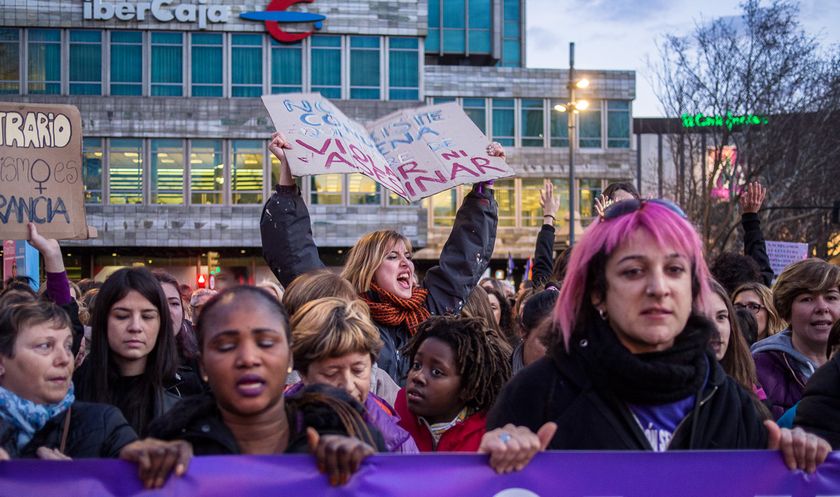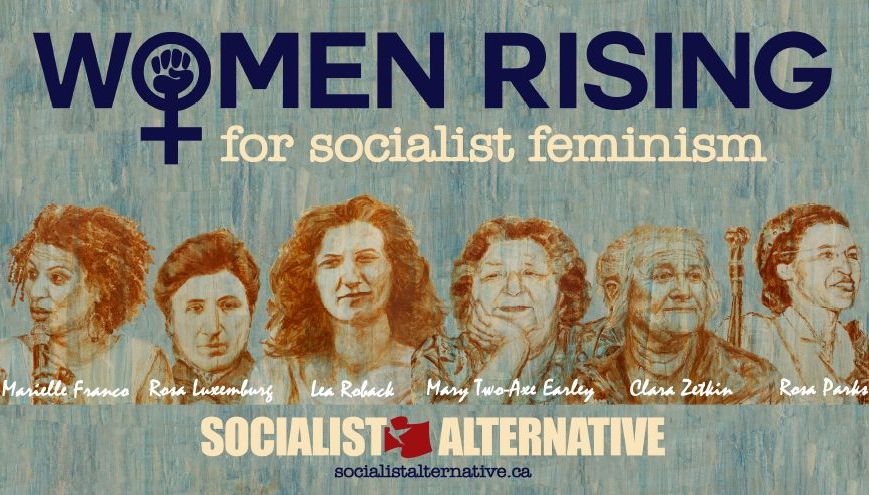Emma Quinn is a member of the Socialist Party (ISA in Ireland).
Socialist Feminism Now More Than Ever
Whenever there is a crisis, be it war, climate catastrophe or a pandemic, it is women, people of colour, indigenous populations; the most oppressed and exploited sections of the poor and working class who are worst affected. Lenin put it well: “Capitalist society is and always has been a horror without end”.[1]
Now, when the system is in the midst of an unprecedented economic and social crisis where basic needs like healthcare, housing and decent standards of living are not available to millions in even the wealthiest capitalist countries, and where sexism, racism, LGBTQ-phobia and division are systematically perpetuated, it is not surprising that those who have experienced the worst brutalities of the system are leading mass struggles against oppression and inequality. In fact, mass protests against oppression have become a defining feature of this era.
Biggest protests in US History
“We have Black sons, Black brothers, Black friends, we don’t want them to die. We are tired of this happening, this generation is not having it, we are tired of oppression,” said Muna Abdi, a 31-year-old Black woman who joined a BLM protest in St Paul, Minnesota.[2]
Captured on camera, the cold-blooded murder of George Floyd served as a catalyst in igniting an uprising of people of colour against the violence and injustice being inflicted upon them on a daily basis by the police and the racist US state. The explosion of protests emerged in the context of a pandemic that has seen the highest level of unemployment since the Great Depression, in which black women are twice as likely as white men to have lost their jobs[3]. Not only more likely to be struggling to pay rent and buy basic necessities, Black people are dying from the Covid-19 disease itself at a significantly disproportionate rate.
The recent Black Lives Matter demonstrations most likely represent the biggest protest movement in the history of the United States with an estimated 15 to 26 million participating in protests in the weeks following the murder.[4] The protests have been more sustained and more widespread than ever before, taking place across all 50 states, including predominantly white rural communities and inspiring a wave of solidarity actions all around the world. The protests have been some of the most ethnically diverse ever seen, with young women especially stepping forward as organisers.
It is not a coincidence that the five biggest protests in US history have taken place since the election of Trump, who himself personifies the deepening crisis of capitalism. The day after his inauguration in January 2017 saw the largest ever single day of protest. This Women’s March was a response to the threat his presidency posed to abortion rights, women, people of colour, the LGBTQ community and the climate. An estimated 7 million people, mainly women, participated in the approximately 673 protests and marches that took place on every continent across the globe.[5]
#MeToo — Ni Una Menos — #IBelieveHer
In November 2019, feminists in Chile epitomised the burning anger of a new generation of activists when they performed the protest chant and dance, “A Rapist In Your Path”. This was a twist on “A Friend In Your Path”, a sexist pro-police anthem which urges little girls to sleep while their “lover cops” protect them. Their performance lacerated ”the oppressive state” and its culture of victim-blaming, ingrained misogyny and police repression of women and working-class anti-austerity protesters. It pointed out that sexual violence doesn’t happen in a political vacuum and very literally pointed thousands of fingers at courtrooms, government buildings and police stations while shouting “the rapist is you”.
Poignantly, older women, including survivors of Pinochet’s terror, performed the chant at the National Stadium in Santiago, which had been used as a prison camp for working-class and socialist activists after the CIA backed military coup in 1973. The crowd was so big that it stopped traffic. The chant resonated all over the world, capturing the essence of the #MeToo and Ni Una Menos (Not One Less) movements. It demonstrated an important shift in consciousness as activists were using the slogan to take aim at the system itself. Women in the US pointed at Trump. Women in Brazil pointed at Bolsonaro. Women in India pointed at Modi and were met with water cannons when they performed it. It has become a global symbol of defiance against sexual violence and state repression.
Millions of women in countries ranging from Argentina, South Africa, the Spanish state and Thailand have marched for abortion rights and against femicide, gender violence, pay inequality and poverty in recent years.
Simultaneously, millions of school students and young people all over the world walked out to demand climate justice. A defining characteristic of these mass movements is that it is women and young people that are playing leading roles. Importantly, these movements are radical and uncompromising, anti-system, international, solidarity-based, multi-racial and LGBTQ inclusive.
Class Struggle Methods to fight Oppression
A common feature is the use of the most powerful methods of struggle of the workers’ movement, including strikes, walkouts and occupations. No better example was the remarkable “Feminist Strike“ on International Women’s Day 2019, which saw around 7 million people shut down the Spanish state with demands against gender-based violence and victim blaming, pay inequality and austerity. The fact that this action was the inspiration for further mass actions globally such as a feminist general strike in Switzerland, mobilisations against gender violence in Israel and Palestine to name just a couple is also in the very best traditions of the working-class movement, namely international solidarity as vital — something that obsequious trade union bureaucrats could take some lessons from! Furthermore, there have also been strike and walkout actions by workers against sexual harassment, including by McDonalds an Google workers.
The movements have won important victories, such as abortion rights in Ireland and a victory for the movement against court-room misogyny in the “Wolfpack” rape case in the Spanish state. They have also had an immeasurably progressive impact on society by forcing the realities of sexism, racism and inequality onto the political agenda, challenging backward and dangerous attitudes and also by frightening capitalism’s ruling class who fear mass struggle of the working class, the poor and the oppressed more than anything else.
Oppression in all its forms is a tool of the ruling class to cut across working-class solidarity and unity in struggle. Therefore, movements against oppression, most especially when they win the solidarity of a large mass of the working class, poor and oppressed, are powerful, not only in striking blows against oppression but in fact in shoring up the whole working-class fight against the capitalist system.
We saw this in the Repeal movement in Ireland that was driven by young women and the LGBTQ community, with socialist feminists playing a critical role and with mass support from working-class communities being a key driver of the ‘Yes’ vote. Not only did the movement succeed in overturning a draconian abortion ban and delivering pro-choice legislation, which included access to abortion for free, it did this at a time when abortion rights are being attacked in many parts of the world. It also succeeded in putting the backward Irish state, political establishment and Catholic Church in the dock.
“In order to change the conditions of life, we must learn to see them through the eyes of women” — Leon Trotsky[6]
Women are more likely to be “essential workers” on the frontline in the fight against Covid-19[7], working as nurses, healthcare assistants, teachers, cleaners, retail workers and hospitality workers. In the main these heavily feminised workforces continue to be the lowest paid, the most precarious and the most exploited. Inevitably, this is reflecting itself in struggle. In Ireland, over the last two years we have seen strike action by nurses, childcare workers and the inspiring (mostly-women) Debenhams workers who have taken on a ruthless multinational company, the political establishment and the courts to defend basic workers’ rights.
In Britain, the Trade Union Congress reported in May 2020 that a significant membership increase had been “driven by an incredible rise in union membership amongst women”.[8]
The Covid-19 pandemic has made the so-called “double shift” into a ”triple shift” for women workers. Gender violence has seen a “horrifying global surge” of femicide and intimate partner abuse[9] . Intimate partner killings in Britain doubled in the first 21 days of lockdown[10]. Reports of domestic violence in the North of Ireland are at the highest since records began[11], and in the south Women’s Aid reported a 43% increase in calls between March and June[12]. Increasingly, evidence is also coming to light about how Covid is disproportionately affecting communities of colour[13].
For all these reasons, the Covid crisis is further sharpening the propensity for working-class and young women and people of colour to be at the forefront of struggle. The New York Times recently reported that, “women were more likely than men to report having participated in protest over the past two years, and that mothers with children in the home were twice as likely as fathers to report participating in a protest”[14]. Study of attitudes of young people in Britain by HopeNotHate found that “leftist activists” were three times more likely to be women and were more likely to report experiencing racism, violence and sexual harassment.[15]
Women Worker Gravediggers
A Marxist analysis centres on the daily realities and material living conditions of working-class people as the driver of their revolutionary potential. This has special resonance in the field of the workplace, where workers come together, experience exploitation in a common way, and conversely when they get organised feel the potential power of their collective struggle in opposition to the same. Rising oppression and exploitation alongside is creating a combustible situation that socialists should be consciously preparing for. Many of the mass struggles against oppression of recent years have happened outside of the structures of the trade union movement. Decades of selling out by trade union bureaucrats has resulted in unions that in some cases are hostile environments for the most fighting layers of workers. A damning report on one of Britain’s biggest trade unions, the GMB, found it to be “institutionally sexist” and that it was“not a comfortable place to be for many employees and members from Black and minority ethnic groups”[16].
As well as continued bursts of struggle emerging outside of established organisations continuing as a likely trend in the combustible world situation, women workers have an indispensable role in the transforming of trade unions into the radical and combative force necessary for the future battles.
The Debenhams workers are a brilliant example of this in Ireland. In the US, which has seen a resurgence of organised labour in the recent few years, this was concretely seen in the teachers’ uprisings, the ‘Red for Ed’ explosion of working-class militancy. Led overwhelmingly by women workers, this opened the door for workers ranging from the service sector to heavy industry to engage in strike action and begin to reclaim their unions as instruments of struggle.
Of course the mass struggles against oppression have not developed without complication. They have hit historic highs and then ebbed. They haven’t yet organised into political organisations nor have they, for the most part, been expressed in a more organised and long-lasting fashion within the organised labour movement. The desire for change has manifested so far in spurts of struggle and fightback, but has the potential to spread, deepen and take root in the working class exactly because capitalism can provide no answers, no fixes, no hope for women, people of colour or the working class itself. These movements are just the beginning of a new political period, not the end of one.
Socialist Feminism versus Feminising the Elite
While huge profits have been made during the pandemic, ordinary people’s lives have been turned upside down. At the same time as there has never been more desire for gender equality and action against systemic racism. There has also been the inevitable confusion and backlash. Emboldened by the likes of Trump, there has been a worrying emergence of an anti-feminist, misogynist, transphobic online culture. From Men’s Rights Activists, Incels (involuntary celibates), Pickup Artists and the now tens of thousands of members of MGTOW (Men Go Their Own Way) under the guise of caring about some of the real issues impacting working-class men, from poverty to mental health, they point the finger at “lying, cheating promiscuous women” and are acting as a gateway to recruitment to the far-right. Feminism is posed by these groups as a way of controlling and repressing men. In Britain, one in five young men have negative views about feminism[17]. The political establishment and the far right have a common interest in using “toxic masculinity” to perpetuate division and pit sections of the working class against each other — posing a real threat to the safety of women.
The nomination of Kamala Harris as running mate for Joe Biden’s presidential campaign triggered an immediete gushing of support from bourgeois feminist organisations. Kamala Harris may be a woman of colour and may pose as a feminist, but like Hilary Clinton, her history is one of advancing establishment interests. “Top Cop” Harris has a political record of siding with Wall Street and the mass criminalisation and incarceration of working class and poor black people. The approach of bourgeois feminism — feminising the elite — has nothing to offer working-class people of any gender.
The most effective way of cutting across the insidious far-right that are pushing anti-feminist, misogynist ideas amongst alienated young men, is through drawing the sharpest possible distinction between socialist feminism and the bourgeois, or corporate or establishment feminism that we are in a fight against. Socialist feminists are fighting to build the widest possible movement and uprising of the working class and all oppressed groups for socialist change. Working-class women have a crucial role to play in this struggle.
As pioneering socialist feminist, Clara Zetkin, remarked in a speech in 1921, those who don’t recognise the same can only be seen as “conscious saboteurs of the revolution”[18], given the reality of the radicalisation of huge swathes of working-class and young women evident around the world today. This is most sharply expressed at this moment in Poland, in which an uprising led by young women against a misogynistic attempt to further ban abortion is inspiring opposition, radicalisation and struggle of the broader working class against the right wing.
[1] https://www.marxists.org/archive/lenin/works/1916/miliprog/ii.htm
[2] https://www.aljazeera.com/news/2020/6/1/tired-of-this-tens-of-thousands-protest-george-floyd-killing
[3] https://www.marketplace.org/2020/04/30/covid-19-economic-impact-risk-racial-disparities/
[4] https://www.nytimes.com/interactive/2020/07/03/us/george-floyd-protests-crowd-size.html
[5] https://www.google.com/url?q=https://www.ft.com/content/7b34cd82-dfe2–11e6–8405–9e5580d6e5fb&sa=D&ust=1603457203518000&usg=AOvVaw1_kJ3zJxzIvbxVAyKJBgFO
[6] https://www.marxists.org/archive/trotsky/1924/xx/bureaucracy.htm
[7] pewresearch.org
[8] https://www.tuc.org.uk/blogs/union-membership-rises-third-year-running-64-million#:~:text=This%20year%27s%20increase%20was%20driven,amongst%20women%20workers%2C%20of%20170%2C000.&text=Union%20membership%20increased%20in%20both,increased%20to%2023.5%20per%20cent.
[10] https://www.theguardian.com/society/2020/apr/15/domestic-abuse-killings-more-than-double-amid-covid-19-lockdown
[11] https://www.belfasttelegraph.co.uk/news/northern-ireland/significant-increase-in-reports-of-domestic-abuse-amid-covid-lockdown-in-northern-ireland-39574392.html
[12] https://www.womensaid.ie/about/newsevents/news/2020/08/20/media-release-rise-in-reports-of-domestic-violence/
[13] https://www.cdc.gov/coronavirus/2019-ncov/community/health-equity/race-ethnicity.html
[14] https://www.nytimes.com/2020/08/17/us/politics/democrats-women-voters-anger.html
[15] hopenothate.org.uk
[16] https://www.theguardian.com/politics/2020/sep/03/gmb-union-institutionally-sexist-inquiry-finds
[17] hopenothate.org.uk
[18] https://www.marxists.org/archive/zetkin/1921/zetkin06.htm




